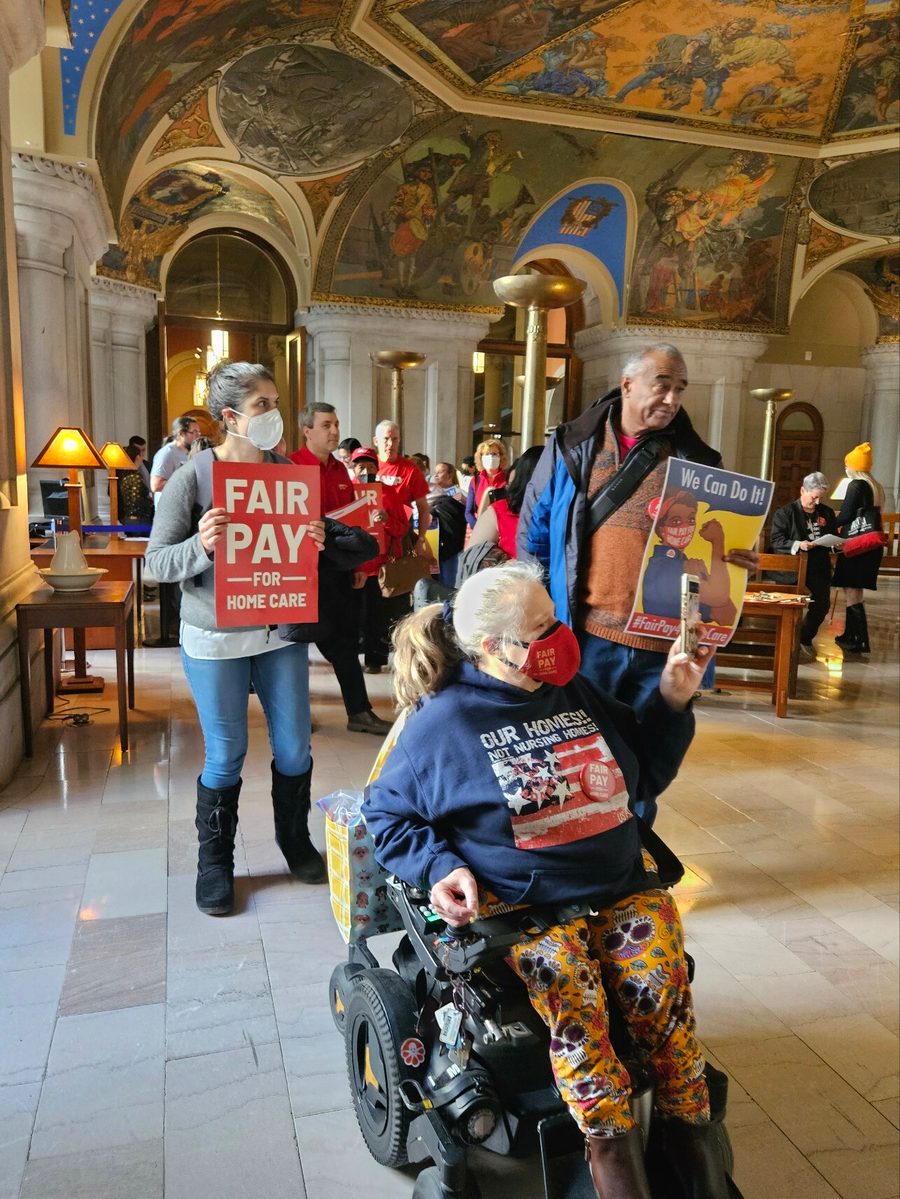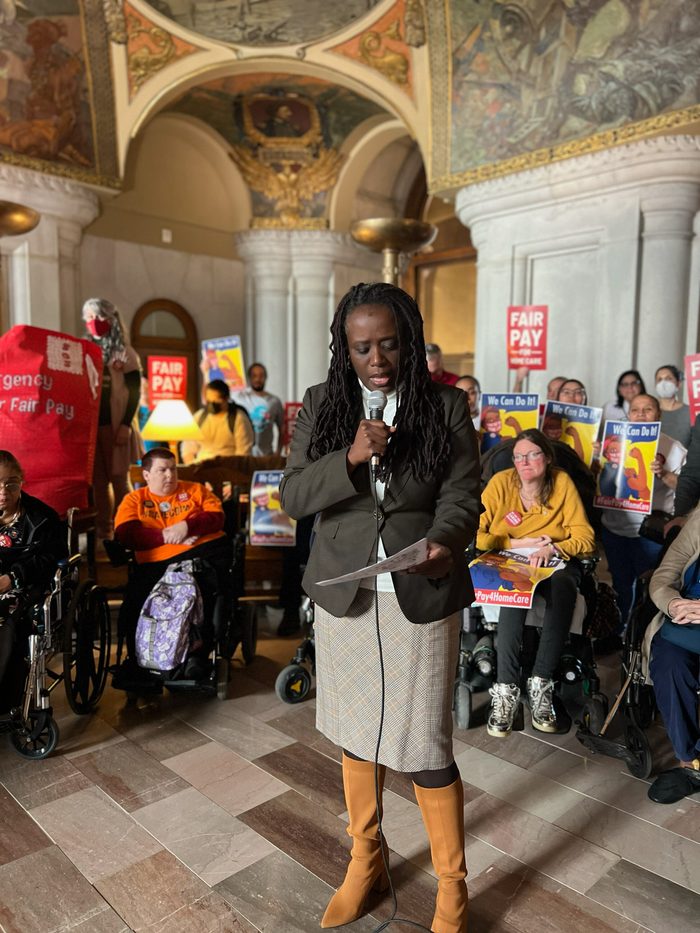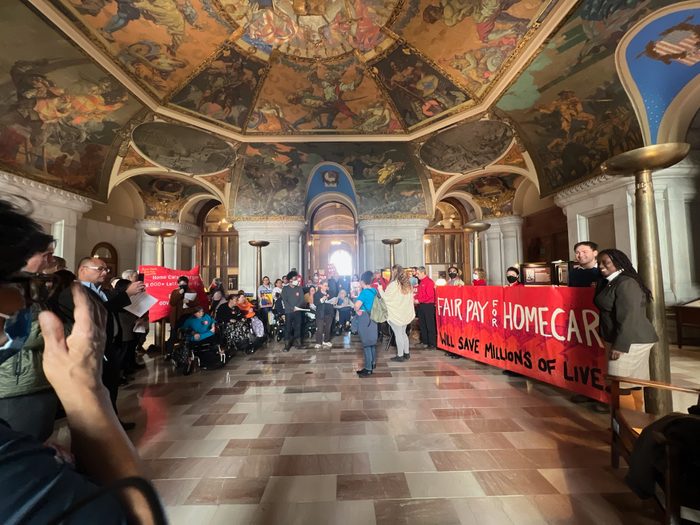Insurance Companies are Destroying New York's Home Care Industry
“Year after year, they’ve been pocketing money meant for home care workers.”
Lily Meyersohn

On Saturday, April 1, New York state lawmakers and Gov. Kathy Hochul failed to agree on a state budget. The governor proposed an extension until April 10, which was quickly passed by lawmakers to avoid a government shutdown — and then passed another extension, which expires Monday. These delays are reportedly because of disagreements over Hochul’s bail reform and controversial plans to create new housing.
But another group is also watching the budget closely: home care workers, users and advocates, who pushed for and won a minimum wage increase for home care workers in the state budget in 2022, only to see those measures rolled back this year. Facing severe worker shortages and what many argue amounts to a crisis in the sector, many advocates say that, rather than correcting these issues, Hochul’s budget makes things “more challenging” and “erects new barriers” to accessing care. At stake is the future of the state’s home care sector — on which millions of rapidly aging New Yorkers depend.
Many home care advocates have called on Hochul not only to raise wages to secure the longevity of the industry, but to ensure that wage increases make their way into care workers’ hands. Within the current structure, these advocates say wage increases often get held up at the level of insurance plans and sometimes at the level of home care provider agencies. Since February, when Hochul proposed her executive budget, advocates have demanded that the budget correct these longstanding structural concerns that impact both home care workers and those for whom they care.
“You can win the money, but it no longer goes into the system”
Every year, the New York Department of Health (DOH) buys long-term care insurance for the state’s elderly and disabled residents. For every resident enrolled in one of these plans, the DOH pays insurers a monthly premium of around $5,000. In exchange, insurers are asked to provide managed long-term care (MLTC) coverage to residents — including covering the cost of home care aides. If the system worked as intended, insurance plans would pay the full cost of aides’ wages and benefits to the agencies (or home care users) who employ them, allowing insured residents to receive quality care from well-compensated aides working at financially sustainable home care agencies.
But the system does not work this way in practice. While MLTC plans — many of which are administered by subsidiaries of insurance giants like Molina, Anthem and Centene — are expected to use state-funded premiums to fully compensate home care providers, they are not actually required to do so. There are no stipulations on how much funding must go from insurance plans to home care agencies – – and there is no requirement that those reimbursement rates cover the exact cost of home care wages and benefits. At a DOH all-stakeholder call in September 2022, department representatives said there is “neither a floor nor a ceiling regarding reimbursements [from MLTC plans] to home care provider agencies.
Because of this pitfall in the sector’s funding structure, money distributed to MLTC plans does not flow smoothly on to home care provider agencies. Kathy Febraio, president and CEO of the home care agency collective New York State Association of Healthcare Providers, tells In These Times that millions of taxpayer dollars get sucked out of the system early on, diverting investments to insurance executives’ pockets while home care provider agencies bear the cost.

In 2021, the most recent full year in which reporting is available, New York state paid 25 MLTC plans $13 billion in Medicaid premiums for home care. In testimony during a February 28 joint legislative public hearing, New York State Assemblymember Jo Anne Simon said financials for the 25 MLTC plans show a total of $720 million in profit in 2021. These sums represent a 5.5% average profit margin — double the national average for Medicaid-managed care plans. “Year after year, they’ve been pocketing money meant for home care workers,” Simon explained.
The problem emerged in 2011, when then-Gov. Andrew Cuomo turned publicly-financed home care over to private insurance companies to reduce state Medicaid spending. Before that point, counties generally disbursed home care funds through their own non-profit insurance plans. Once Medicaid began to increasingly be administered by for-profit insurance companies, home care reimbursement rates fell. Since then, insurance plans have covered fewer hours of care per patient, leading many home care agencies to cut personnel costs. After a decade of privatization, the minimum hourly wage for home care workers stagnated at $15 in Long Island, Westchester and New York City, and just $13.20 in the rest of the state.
Things seemed to improve in 2022, when Governor Hochul invested $7.7 billion in the sector and raised the home care minimum wage across New York. Bryan O’Malley, executive director of the home care advocacy group Consumer Directed Personal Assistance Association of New York State, tells In These Times home care agencies were “thrilled” by the investment. But they soon realized the funds were not actually reaching workers. “Because the DOH does not hold insurance companies accountable,” O’Malley says, “public money [meant] to pay for wage increases often stops at the insurance company” — enabling MLTC plans to “reap huge profits” every time home care workers’ wage is increased.
“You can win the money,” O’Malley reflects, “but it no longer goes into the system, it goes into insurance companies.”
$2 raise, 20 cent reimbursement
In October 2022, Febraio wrote to the state legislature to explain that lawmakers’ “well-intentioned efforts” to ameliorate the home care crisis had been undermined by MLTC plans. Insurance industry representatives disagreed and wrote their own letter to the State Assembly and Senate, stating that “no plan is paying any provider less than they need to meet wage, benefit, and administrative requirements.” In an email statement to In These Times, Leslie Moran, senior vice president of the New York Health Plan Association — which represents 27 MLTC plans that serve more than 8 million New Yorkers — claims that “any suggestion that the plans are withholding funding is inaccurate.” Moran says MLTC plans have worked “diligently to allocate fair wage funding to home care providers,” pointing out that in some cases, existing contracts “exceeded the wage and benefit requirements.”
Yet many home care providers recount a different experience. To cover the recent $2 per hour increase in the home care wage, agency representatives say they need an average of $2.66 to cover payroll taxes, overtime, paid time-off, health insurance and other benefits. But in two recent contracts between MLTC plans and home care agencies (provided to In These Times by advocacy coalition New York Caring Majority), insurance plans only offered home care agencies a reimbursement increase of 50 cents and 20 cents respectively to cover the $2 wage increase. The rest of the money remains with the MLTC plans, says O’Malley.
Adria Powell, president and CEO of Bronx-based home care agency Cooperative Home Care Associates (CHCA) — which is also the largest employee-owned cooperative business in the country — tells In These Times that CHCA is “struggling because [they] aren’t getting enough in [their] reimbursement rates.” Without adequate reimbursement, some providers have paid for the raise out of pocket; others tapped into various lines of credit.
When providers are stressed for cash, they may also decline new cases, turn away customers with particular insurance plans, reduce staffing levels or hours of service or cut down on crucial benefits like overtime, says Febraio. O’Malley adds that upstate agencies in particular slashed worker benefits after the first wage increases in 2022, steps that significantly worsened home care conditions and put the stability of the whole sector at risk.
The fight to empower regulators
In recent years, groups like New York Caring Majority have been agitating for the state to hold MLTC plans accountable — starting with increased oversight over their contracts with home care agencies. Currently, those contracts are negotiated privately; because agencies have little leverage in negotiations compared with MLTC plans, the contracts tend to leave insurers with excess profits while agencies struggle to keep their doors open. Advocates say this imbalance could be corrected if the state had greater purview over home care contracts.
When state Sen. Rachel May went to the State Comptroller Thomas DiNapoli in 2022 to raise concerns about contracts favoring MLTC plans over home care agencies, DiNapoli said he could not address any issues in the contracts. A press secretary for the comptroller confirmed the exchange, telling In These Times that, because the contracts between MLTC plans and providers are between private parties, the Office of the State Comptroller has “no legal authority to review [them]. This is an issue for the Department of Health.”
But even the DOH is shirking this responsibility, says O’Malley. In its email to In These Times, the DOH rejected the notion that insurance plans are holding on to more than their fair share. The plans “cannot legally keep… wage increase money,” they wrote, “due to Medical Loss Ratio requirements in accordance with federal regulation.” Enforcement, however, remains an issue. While the DOH said it had informed MLTCs that withholding wage increases is a violation of federal requirements, enforcement remains an issue. Febraio notes that elsewhere, the DOH has indicated that it would not intervene because the relationship between plans and providers is subject to private contract negotiations. Moreover, because the contracts are proprietary, the DOH isn’t even aware of all the rates they include, leaving agencies to fend for themselves. Even when the DOH has the authority to intervene, advocates say it doesn’t have the resources to meddle in each individual contract.

Advocates believe the first step in reforming this system is to make it more transparent. In 2021, the Caring Majority coalition helped introduce the Fair Pay for Home Care Act, S3189, a bill that not only raises home care workers’ minimum wage to a sustainable level but also increases the power of the DOH and the state comptroller to oversee contracts between MLTC plans and home care providers. The bill’s text creates a minimum reimbursement amount MLTC plans must provide to home care agencies and dictates a clearly defined pathway for state and federal funds to flow through the system, ensuring that state funds get to workers.
“We had good language” in the original bill, May (the bill’s sponsor) tells In These Times. In previous years, the State Senate and Assembly have each included accountability language from S3189 in their respective one-house budget resolutions. Meanwhile, legislators have been strengthening the bill itself, May adds. New language added in 2023 grants the state comptroller the power to ensure that rates offered in MLTC plan contracts meet DOH standards. The new language also shores up the state’s ability to enforce compliance for insurers that provide subpar reimbursement rates by referring them to the fraud control.
Despite these legislative efforts, the executive branch actively avoids attempts to increase the state’s leverage, says O’Malley. Language from S3189 never made it into the final round budget—neither in 2022 nor 2023. In each case, O’Malley says insurance company executives pushed forward watered-down, “toothless” accountability language. O’Malley, who was the former Assembly Health Committee Chair, says that with a few exceptions the state’s answer to complaints “always has been and remains: We don’t get involved in private negotiations between third parties.”
“More accountability at all levels”
Given most insurance plans’ massive profits, MLTC plans are the main target of new accountability measures. (New York’s most profitable MLTC plans all have individual net revenues of over $30 million.) But in the post-2011 landscape, where most of the state’s home care providers are for-profit, worker advocates are also demanding accountability at the provider level.
Most home care agencies are businesses where owners take home the lion’s share of annual profits. While O’Malley believes it is a misconception that agency CEOs “are getting dramatically wealthy off of these plans,” Powell notes that except for worker-owned enterprises like CHCA, home care agencies still distribute profits unequally. (MLTC plans themselves have also accused some agencies of seeking fair wage funding not to increase worker salaries but for their own profit.)
Helen Schaub, a policy and legislative director for
1199SEIU United Healthcare Workers East — a union representing at least
75,000 home care workers in New York — tells In These Times that
many agencies have their own transparency issues to work on. After two
decades of fighting, in 2019 the union finally managed to get New York
to require agencies to file public cost reports,
which make home care providers’ use of Medicaid funds transparent.
1199SEIU has also used mechanisms external to the DOH to effect change.
In 2019, for instance, the union filed a class action grievance with the state attorney general,
alleging on behalf of union members that 42 home care agencies had
violated state and federal wage and hour laws. The grievance resulted in
a forced arbitration settlement that required the agencies to create a
fund for those workers (though critics of forced arbitration say the
tactic results in lower payouts to members in exchange for the financial
security of home care agencies).

After the October 2022 home care wage increase, 1199SEIU heard from many upstate workers who did not receive their raise. “Under the current system,” Schaub says, “it’s hard to know whose fault that is … more accountability is needed at all levels within the system.”
All eyes on Albany
Advocates say Hochul’s proposed budget fails to include the necessary oversight mechanisms to protect home care workers. Groups like New York Caring Majority are continuing to push for the full inclusion of S3189 in the budget and have maintained a constant presence at the state Capitol in the days leading up to the April 1 deadline. During the budget’s extension period, advocates urged supporters to write letters to the editor to newspapers across New York to tell Hochul that she must “lead the nation by including Fair Pay for Home Care” in the final state budget.
Home care agencies are also anxiously awaiting news of budget updates. Febraio tells In These Times she had been “hoping for more” from the state in terms of accountability this year. Her organization, she says, has been “loud and clear” in telling the legislature and the administration that “structural challenges within the payment system need to be addressed.”
Whatever changes Hochul includes in the final budget will have life-changing consequences for home care workers as well as for people across the state who rely on their care. When home care wages remain on par with minimum wage, home care aides may look to other jobs that pay just as well but don’t require them to shoulder the kinds of emotional and physical responsibilities that care work entails — which is why S3189 proposes a home care wage that will always be 150% of the state minimum wage. But a higher wage alone is not adequate if it doesn’t include guardrails to ensure that MLTC plans can’t skim state funds. Unless contracts include sufficient reimbursement rates, Powell is concerned that home care agencies will continue to be pushed into “cost-saving” measures, such as declining clients in need, reducing hours of service or slashing aides’ benefits.
Renee Christian, a 34-year-old single mother, wellness coach and home care user based in Buffalo, N.Y., tells In These Times that she struggles to find full coverage and is currently at risk of losing one of her crucial overnight aides, Denise White, who makes “just enough” money that she is no longer eligible for the local rental assistance program that she previously relied on. But White can still “barely make ends meet.”
Because this precarity affects both of them, Christian — who is active in home care advocacy efforts — sees the movement for fair pay as one built on reciprocity. It’s about “valuing people,” she says: “not just the providers of service, but also the people who get the service.”
Lily Meyersohn is a researcher for the Institute for Public Accuracy and a freelance health and politics reporter. She can be reached at @LMeyersohn.





